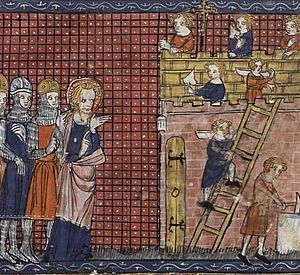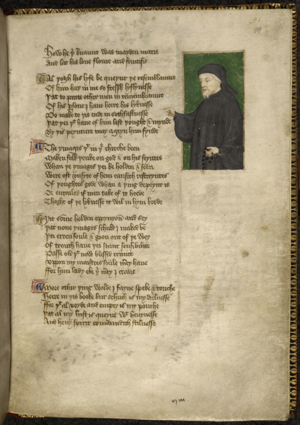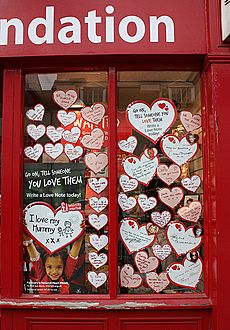Valentine's Day facts for kids
Template:Infobox vevent
Valentine's Day, also known as Saint Valentine's Day or the Feast of Saint Valentine, is celebrated every year on February 14. It started as a Christian holiday to honor a saint named Saint Valentine. Over time, it also became a popular cultural and commercial celebration of love and friendship around the world.
There are many stories about different Saint Valentines linked to February 14. One story tells of Saint Valentine of Rome being put in prison for helping Christians who were being treated badly in the Roman Empire. It is said that Saint Valentine made the blind daughter of his jailer see again. Later stories added more about love: some say he secretly married Christian soldiers who were not allowed to marry. An 18th-century story claims he wrote a letter to the jailer's daughter, signing it "Your Valentine," before he was executed.
The celebration of Saint Valentine's Day on February 14 was first written down in the 8th century. The day became linked with romantic love in the 14th and 15th centuries. This was when ideas of courtly love were popular. In 18th-century England, it became a time for couples to show their love. They would give flowers, sweets, and greeting cards, which were called "valentines." Today, common symbols for Valentine's Day include heart shapes, doves, and Cupid, a winged figure. In the 19th century, handmade cards were replaced by cards made in factories. In Italy, special "Saint Valentine's keys" are given to lovers. They are a symbol of unlocking someone's heart.
Saint Valentine's Day is not a public holiday in any country. However, it is an official feast day in the Anglican and Lutheran Churches. Some parts of the Eastern Orthodox Church also celebrate Saint Valentine's Day on July 6 and July 30.
Contents
Who Was Saint Valentine?
The History of Saint Valentine
Many early Christian saints were named Valentine. The Valentines honored on February 14 are Valentine of Rome and Valentine of Terni. Valentine of Rome was a priest in Rome who died as a martyr in 269 AD. His remains were kept in the Church and Catacombs of San Valentino in Rome. Other remains are found in Dublin, Ireland.
Valentine of Terni became a bishop in Italy. He is said to have died as a martyr in 273 AD. His remains are in the Basilica of Saint Valentine in Terni. Many churches and monasteries in Europe had stories about these two saints.
The Catholic Encyclopedia mentions a third Saint Valentine. He was a martyr in Africa on February 14, but not much else is known about him.
February 14 is celebrated as St. Valentine's Day in several Christian groups. In 1969, the Roman Catholic Church decided that Saint Valentine's Day would be celebrated more locally. This was because not much was known about him, except his name and where he was buried. However, he is still remembered in the Roman Martyrology.
The day is still celebrated in Balzan, Malta, where some of the saint's remains are believed to be. It is also celebrated by Traditionalist Catholics worldwide.
In the Eastern Orthodox Church, Saint Valentine of Rome is honored on July 6. Hieromartyr Valentine, Bishop of Interamna, is honored on July 30.
Famous Stories About Saint Valentine

J.C. Cooper writes that Saint Valentine was a priest in Rome. He was imprisoned for helping Christians who were being persecuted. Records from that time were likely destroyed. In the 5th or 6th century, a story about Saint Valentine of Rome's martyrdom was written.
This story also appears in Bede's Martyrology from the 8th century. It says that Saint Valentine was questioned by Roman Emperor Claudius II. Claudius was impressed by Valentine and tried to make him change to Roman paganism. Valentine refused and tried to convert Claudius to Christianity instead. Because of this, he was executed. Before he died, he is said to have healed Julia, the blind daughter of his jailer, Asterius. Asterius and his entire household then became Christians.
A later story added that Pope Julius I built a church over Valentine's tomb. This legend was then repeated in other writings, like The Golden Legend in the 13th century.
An 18th-century addition to The Golden Legend says that Valentine wrote the first "valentine" card. He supposedly wrote it to the jailer's daughter, Julia, before his execution. He signed it "Your Valentine." This is where the phrase "From your Valentine" may have come from.

Some historians say that Saint Valentine was buried in the Church of Praxedes in Rome. It is said that Julia planted a pink-blossomed almond tree near his grave. Today, the almond tree is a symbol of lasting love and friendship.
Another story suggests that Saint Valentine secretly performed Christian weddings for soldiers. The Roman Emperor Claudius II supposedly did not allow soldiers to marry. He believed that married men were not good soldiers. However, some historians say this marriage ban never happened.
According to legend, Saint Valentine cut hearts from parchment to remind soldiers of their promises and God's love. This might be why hearts are so widely used on St. Valentine's Day.
Saint Valentine supposedly wore a purple amethyst ring. This ring had a picture of Cupid on it, a symbol of love. Roman soldiers would recognize the ring and ask him to marry them. Because of this link, amethyst has become the birthstone for February. It is thought to attract love.
Old Traditions
While many old European traditions for Valentine's Day have been replaced by modern romantic customs, some links to the start of spring still exist.
The custom of sending cards, flowers, and chocolates began in the UK. Valentine's Day still has different local customs in England. In Norfolk, a character called 'Jack' Valentine knocks on doors. He leaves sweets and presents for children.
In Slovenia, Saint Valentine was a saint of spring. He was known for good health and was the patron saint of beekeepers. A saying goes, "Saint Valentine brings the keys of roots." This means plants and flowers start to grow on this day. It was also the day when work in vineyards and fields began. People also said that birds proposed or married on that day. Another saying is "Valentine – the first spring saint." Valentine's Day has only recently become a day for romantic love in Slovenia. The traditional day for love was March 12 or February 22.
How Valentine's Day Became About Romantic Love
Possible Old Roots
The "Feast" of Saint Valentine started in Christianity. It honored one of the Christian martyrs named Valentine. Some people thought it was linked to an ancient Roman festival called Lupercalia. This festival was held in Rome from February 13–15. It was about purification and health, not romantic love. The celebration of Saint Valentine is not known to have had romantic meanings until Geoffrey Chaucer's poetry in the 14th century. This was about 700 years after Lupercalia is believed to have ended.
Some researchers have thought that Pope Gelasius I replaced Lupercalia with a Christian holiday. However, there is no proof that he intended to link it to romantic love.
Alban Butler claimed that during Lupercalia, boys and girls would draw names from a jar to form couples. He said that modern Valentine's letters came from this. But this practice actually started in the Middle Ages. Priests tried to stop it, sometimes by having girls draw names of apostles instead.
Chaucer's Parliament of Fowls

The first time Valentine's Day was linked to romantic love was likely in Parliament of Fowls (1382) by Geoffrey Chaucer. This poem describes a meeting where birds choose their mates. Chaucer wrote it to celebrate the first anniversary of King Richard II of England's engagement to Anne of Bohemia.
Many people thought Chaucer was talking about February 14. However, some scholars believe he might have meant the feast day of St. Valentine of Genoa, which was probably on May 3. A treaty for Richard II and Anne's marriage was signed on May 2, 1381.
Also, the date when spring begins has changed since Chaucer's time. On the calendar used then, February 14 would have been like February 23 today. This is when some birds in England start mating.
Chaucer's poem talks about an already existing tradition, but there is no record of it before him. The idea that Valentine's Day customs came from Roman Lupercalia has been repeated often.
Court of Love
The earliest description of February 14 as a yearly celebration of love is in the Charter of the Court of Love. This document, supposedly from Charles VI of France in 1400, describes big parties. These included feasts, love songs, poetry contests, and dancing. During these events, ladies would listen to and decide on arguments between lovers. No other record of this court exists.
Valentine Poetry
The oldest surviving valentine is a poem from the 15th century. It was written by Charles, Duke of Orléans to his wife. He was held in the Tower of London after being captured in 1415.
The earliest English valentines are in the Paston Letters from 1477. Margery Brewes wrote to her future husband, John Paston, calling him "my right well-beloved Valentine."
Valentine's Day is mentioned in William Shakespeare's play Hamlet (1600–1601) by Ophelia.

The poet John Donne used the story of birds marrying on Valentine's Day. He wrote a poem celebrating the marriage of Elizabeth, daughter of James I of England, on Valentine's Day.
The famous verse "Roses are red" comes from old poems. It can be found in Gammer Gurton's Garland (1784), a collection of English nursery rhymes.
Modern Times
In 1797, a British publisher released The Young Man's Valentine Writer. It had many suggested verses for young lovers. Printers started making cards with verses and drawings, called "mechanical valentines." Paper Valentines became very popular in England in the early 19th century. They were even made in factories. Fancy Valentines used real lace and ribbons. In 1835, 60,000 Valentine cards were sent in the UK.
When postal rates became cheaper in 1840, more Valentines were sent. This made it easier to send cards anonymously. This might be why more daring verses appeared on cards during the otherwise strict Victorian era. Production grew, with over 3,000 women working to make cards.
In the United States, the first mass-produced Valentines were made after 1847 by Esther Howland of Worcester, Massachusetts. She was inspired by an English Valentine. Howland started her business by importing paper lace and decorations from England.
By 1849, Valentine's Day was becoming a national holiday in the US. Since the 19th century, handmade cards have been replaced by cards made in factories. In the UK, almost half the population spends money on Valentines. In 2015, about £1.9 billion was spent on cards, flowers, chocolates, and other gifts.
In 1868, the British chocolate company Cadbury made heart-shaped boxes of chocolates for Valentine's Day. Boxes of chocolates quickly became linked with the holiday. In the second half of the 20th century, people started giving all kinds of gifts, like jewelry.
In the US, about 190 million valentines are sent each year. This does not include the millions of cards exchanged by schoolchildren. Teachers often receive the most valentines. The average spending on Valentine's Day in the US has increased every year.
The rise of the Internet has created new traditions. Millions of people now send digital Valentine's Day messages, like e-cards or love coupons. Some people call Valentine's Day a "Hallmark holiday" because it has become so commercial.
Today, some Christian churches, like the Lutheran and Anglican Churches, have services for St. Valentine's Day. These can include renewing marriage vows. In 2016, Catholic bishops in England and Wales started a special prayer to help single people find a spouse before Valentine's Day.
Valentine's Day Around the World
Valentine's Day customs, like sending cards, sweets, and flowers, started in England. They spread through English-speaking countries in the 19th century. Later, these customs spread to other countries, similar to how Halloween or parts of Christmas spread.
Valentine's Day is celebrated in many East Asian countries. People in Singapore, China, and South Korea spend the most money on Valentine's gifts.
Americas
Latin America
In most Latin American countries, like Mexico and Puerto Rico, Valentine's Day is called Día de los Enamorados (Day of Lovers) or Día del Amor y la Amistad (Day of Love and Friendship). People also often do "acts of appreciation" for their friends.
In Guatemala, it is called Día del Cariño (Affection Day). Some countries, like the Dominican Republic and El Salvador, have a tradition called Amigo secreto (Secret friend). This is like the Christmas tradition of Secret Santa.
Brazil
In Brazil, Dia dos Namorados (Lovers' Day) is celebrated on June 12. This is usually the day before Saint Anthony's day, who is known as the 'marriage saint'. On this day, many single women do special rituals to find a good husband. Couples exchange gifts, chocolates, cards, and flowers. February 14 is not celebrated much in Brazil. This is because it is usually too close to Brazilian Carnival, which lasts almost a week.
Colombia
Colombia celebrates Día del amor y la amistad on the third Saturday in September. Amigo Secreto is also popular there.
United States

In the United States, about 190 million Valentine's Day cards are sent each year. This does not count the hundreds of millions of cards exchanged by schoolchildren.
Valentine's Day is a big economic event. In 2017, people spent over $18.2 billion, or more than $136 per person. However, a 2019 survey found that fewer people were celebrating Valentine's Day. The main reasons were that it felt too commercial, not having a partner, or simply not being interested.
Asia
Afghanistan
Before the Taliban, Flower Street in Kabul was decorated with beautiful flower arrangements for Valentine's Day. In Afghan tradition, love is often shown through poetry. Young poets use Valentine's Day to write about love and freedom.
Bangladesh
Valentine's Day was first celebrated in Bangladesh in 1993. A journalist named Shafik Rehman introduced it after studying in London. He is called the "father of Valentine's Day in Bangladesh." On this day, people show love to partners, friends, family, and teachers with flowers, chocolates, and gifts. Parks and recreation centers are full of people. It is not a public holiday.
Some people in Bangladesh feel that celebrating this day is not right for their culture or Islam. Before Valentine's Day, February 14 was a day against strict rule in Bangladesh. But now, that day is often overlooked for Valentine's Day.
China
In Chinese, Valentine's Day is called lovers' festival (Qīng Rén Jié). The "Chinese Valentine's Day" is the Qixi Festival. This is celebrated on the seventh day of the seventh month of the lunar calendar. A legend says that two stars, the Cowherd and the Weaver Maid, are separated by the Milky Way. They are allowed to meet by crossing it on this day.
Recently, celebrating White Day has also become popular among some young people.
India
In ancient India, there was a tradition of honoring Kamadeva, the god of love. This tradition was lost around the Middle Ages.
Valentine's Day celebrations did not become popular in India until about 1992. It spread because of TV channels like MTV, radio shows, and love letter contests. Also, economic changes allowed the valentine card industry to grow. The celebration has changed how people show affection in public.
A 2018 survey found that 68% of people did not want to celebrate Valentine's Day. Different religious groups, including Hindu, Muslim, and Christian people, often do not support it.
Some traditionalists see the holiday as a bad influence from Western culture. Groups like Shiv Sena have asked people to avoid the holiday. They say it is "alien to Indian culture." They fear it will harm traditions like arranged marriages. Despite these challenges, Valentine's Day is becoming more popular in India.
Some Indian intellectuals criticize Valentine's Day as "Western imperialism." They say it exploits working classes through commercialism. They also say that media attacks on those who oppose Valentine's Day are unfair.
Right-wing Hindu groups are also against it. In 2012, a leader warned couples that "They cannot kiss or hug in public places. Our activists will beat them up."
In February 2023, the Animal Welfare Board of India asked Indians to celebrate February 14 as "Cow Hug Day." They said it would bring "emotional richness" and happiness. They mentioned that cows are sacred in Indian culture. This idea was later withdrawn after it led to many jokes and memes.
Iran

Valentine's Day in Iran dates back to the late 19th century. A king, Naser al-Din Shah Qajar, sent his wife a Valentine's card from Europe. This card is now in Iranian museums.
Since the mid-2000s, Valentine's Day has become very popular in Iran, especially among young people. However, Iranian conservatives criticize it. They see it as part of "decadent" Western culture. Since 2011, authorities have tried to stop celebrations. They have restricted the sale of Valentine's Day items. Despite this, the holiday remains popular. There have also been efforts to bring back an ancient Persian festival, Sepandārmazgān, to replace Valentine's Day.
Israel
In Israel, the Jewish tradition of Tu B'Av has been revived. It is now like a Jewish Valentine's Day. It is celebrated on the 15th day of the month of Av (usually in late August). In ancient times, girls would dance in white dresses in the vineyards. Today, Tu B'Av is a popular day for secular people to declare love, propose marriage, and give gifts.
Japan
In Japan, Morozoff Ltd. first introduced Valentine's Day in 1936. They advertised to foreigners. Later, in 1953, they promoted giving heart-shaped chocolates. Other Japanese candy companies followed. In 1958, a department store had a "Valentine sale." Campaigns in the 1960s made the custom popular.
The custom that only women give chocolates to men might have started from a mistake. Women, especially office workers, give chocolate to their male co-workers. Unlike Western countries, gifts like cards or flowers are less common. Most gift-giving is about giving the right amount of chocolate to each person. Japanese chocolate companies make half their yearly sales during this time.
Many women feel they must give chocolates to all male co-workers. This is called giri-choko (obligation chocolate). Unpopular co-workers might get cheap "ultra-obligatory" chocolate. This is different from honmei-choko (true feeling chocolate), which is given to someone you love. Friends, especially girls, might exchange tomo-choko (friend chocolate).
In the 1980s, a campaign made March 14 a "reply day." Men are expected to give non-chocolate candy to women who gave them chocolates on Valentine's Day. This is called White Day.
In Japan, the romantic "date night" for couples is celebrated on Christmas Eve.
Lebanon
Saint Valentine is a patron saint for many in Lebanon. Couples use Valentine's Day to exchange sweet words and gifts. These gifts often include chocolates, cupcakes, and red roses. Red roses are a symbol of sacrifice and passion.
Lebanese people celebrate Valentine's Day differently in each city. In Beirut, men take women out to dinner and buy them gifts. Many women are proposed to on this day. In Sidon, Valentine's Day is celebrated with the whole family. It is more about family love than just a couple's love.
Malaysia
Islamic officials in West Malaysia have warned Muslims not to celebrate Valentine's Day. They link it to bad activities. They say celebrating romantic love is "not suitable" for Muslims. A religious ruling in 2005 said the day is linked to Christianity. Officials planned a campaign to stop Muslims from celebrating on February 14, 2011.
On Valentine's Day 2011, religious authorities arrested over 100 Muslim couples. Some were charged for breaking the ban.
In East Malaysia, the celebration is more accepted among young Muslim couples. However, some officials from West Malaysia have tried to spread the ban there. In both Sabah and Sarawak, the celebration is common with flowers.
Pakistan
Valentine's Day came to Pakistan in the late 1990s with special TV and radio programs. The Jamaat-e-Islami Pakistan political party has asked for a ban on Valentine's Day. Despite this, the celebration is becoming popular among young people in cities. Florists expect to sell many flowers, especially red roses. Card publishers also see high sales.
In 2016, the local government in Peshawar officially banned Valentine's Day celebrations. The ban was also put in place in other cities like Kohat.
In 2017, the Islamabad High Court banned Valentine's Day celebrations in public places in Pakistan. More than 80% of readers of the Dawn newspaper agreed with this decision.
In 2018, the Pakistan Electronic Media Regulatory Authority told broadcasters and newspapers not to show any Valentine's Day celebrations.
Philippines
In the Philippines, Valentine's Day is called Araw ng mga Puso. It is celebrated much like in the West. The price of flowers, especially red roses, goes up a lot. It is the most popular day for weddings, and some places offer free group ceremonies.
Saudi Arabia
In Saudi Arabia, in 2002 and 2008, religious police banned the sale of all Valentine's Day items. They told shops to remove any red items. This is because the day is seen as a Christian holiday. This ban created a black market for roses and wrapping paper. In 2012, the religious police arrested over 140 Muslims for celebrating. They took all red roses from flower shops. Muslims are not allowed to celebrate, and non-Muslims can only celebrate in private.
A Saudi cleric said that celebrating this holiday is forbidden. He called it a forbidden new practice and copying the West.
However, in 2017 and 2018, the religious police did not stop Muslims from celebrating. A Saudi cleric said that Valentine's Day is not forbidden and fits with Islamic values.
Singapore
People in Singapore are among the biggest spenders on Valentine's Day. About 60% of Singaporeans said they would spend between $100 and $500 during the time leading up to the holiday.
South Korea
In South Korea, women give chocolate to men on February 14. Men give non-chocolate candy to women on March 14 (White Day). On April 14 (Black Day), those who did not receive anything on February or March 14 go to a Chinese-Korean restaurant. They eat black noodles (jajangmyeon) and think about their single life. Koreans also celebrate Pepero Day on November 11. Young couples give each other Pepero cookies. The date '11/11' looks like the long shape of the cookie. The 14th of every month marks a love-related day in Korea, though most are not well-known.
Taiwan

In Taiwan, the traditional Qixi Festival, Valentine's Day, and White Day are all celebrated. However, it is the opposite of Japan. Men give gifts to women on Valentine's Day, and women give gifts back on White Day.
Europe
Estonia and Finland
In Finland, Valentine's Day is called ystävänpäivä, which means "Friend's Day." As the name suggests, this day is more about remembering friends, not just romantic partners. In Estonia, Valentine's Day was first called valentinipäev. Later, it was also called sõbrapäev (Friend's Day), similar to the Finnish name.
France
In France, a traditionally Catholic country, Valentine's Day is known as "Saint Valentin." It is celebrated much like in other Western countries. The remains of Saint Valentin de Terni are in a Catholic church in Roquemaure, Gard. The "Fête des Amoureux" (Lovers' Festival) happens every two years on the Sunday closest to February 14. The village dresses in 19th-century costumes for the event.
Greece
St. Valentine's Day, or Ημέρα του Αγίου Βαλεντίνου, was not traditionally linked to romantic love in Greece. In the Eastern Orthodox church, there is another saint who protects people in love, Hyacinth of Caesarea. However, this was not widely known until the late 1990s. Today, Valentine's Day is generally celebrated in Greece like in Western countries.
Ireland
On Saint Valentine's Day in Ireland, many people seeking true love visit the Shrine of St. Valentine in Whitefriar Street Carmelite Church in Dublin. This church is said to hold remains of Saint Valentine of Rome. People pray at the shrine hoping to find romance. There is a book where people write their prayer requests for love.
Poland
Saint Valentine's Day came to Poland through Bavaria and Tyrol. It became popular in the 1990s. The biggest public celebration in Poland has been held every year since 2002 in Chełmno. It is called „Walentynki Chełmińskie” (Chełmno Valentine's). The church in Chełmno has held a relic of St. Valentine since the Middle Ages. This local tradition has mixed with the Anglo-Saxon customs.
Portugal
In Portugal, the holiday is called "Dia dos Namorados" (Lover's Day). Like elsewhere, couples exchange gifts. In some regions, women give a lenço de namorados (lovers' handkerchief). These are usually embroidered with love designs.
Romania
Recently, Romania has also started celebrating Valentine's Day. This has caused some groups to criticize it. They say Valentine's Day is shallow, too commercial, and a foreign influence. To counter this, the traditional Romanian holiday for lovers, Dragobete, has been revived. Dragobete is a spring festival. It is named after a character from Romanian folklore. Its date used to change, but now it is usually celebrated on February 24.
In Denmark and Norway, February 14 is called Valentinsdag. It is celebrated much like in the United Kingdom. In Sweden, it is called Alla hjärtans dag ("All Hearts' Day"). However, it is not widely celebrated. A 2016 survey showed that less than 50% of people planned to buy gifts for their partners. The holiday has only been observed since the 1960s.
Spain
The holiday was first introduced in Spain in 1948 by a department store. It became widespread by the 1970s.
Known as "San Valentín," the holiday is celebrated the same way as in other Western countries.
United Kingdom
In the UK, almost half the population spends money on Valentines. About £1.3 billion is spent yearly on cards, flowers, chocolates, and other gifts. An estimated 25 million cards are sent.
In Wales, some people celebrate Dydd Santes Dwynwen (St. Dwynwen's Day) on January 25. This is instead of, or in addition to, Valentine's Day. It honors St Dwynwen, the Welsh patron saint of love.
In a 2016 poll, Jane Austen's line, "My heart is, and always will be, yours," from her novel Sense and Sensibility, was voted the most romantic line.
Restrictions on Valentine's Day
The celebration of Valentine's Day has been banned in Indonesia, Pakistan, and Saudi Arabia. This is because people believe the holiday conflicts with Islamic culture.
Since 2009, certain practices related to Valentine's Day are banned in Iran. This includes giving flowers, cards, or other gifts. Iran's police prosecute those who sell items with Valentine's Day symbols. In 2021, the Prosecutor's Office in Qom, Iran, said it would prosecute those who spread "anti-cultural symbols" like those of Valentine's Day. Even though Valentine's Day is not officially approved in Iran, it is very popular among many people.
See also
 In Spanish: Día de San Valentín para niños
In Spanish: Día de San Valentín para niños
- World Kiss Day
- Women's Memorial March, held on Valentine's Day in Vancouver, British Columbia.











